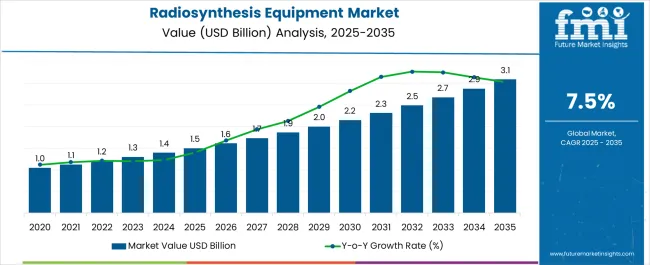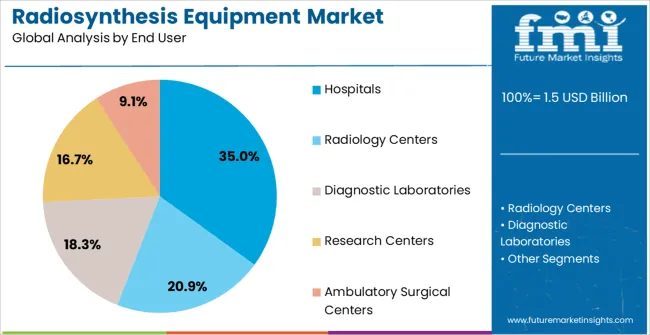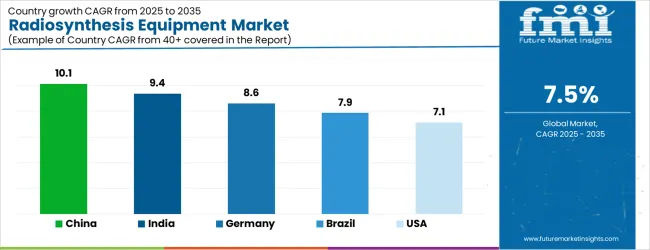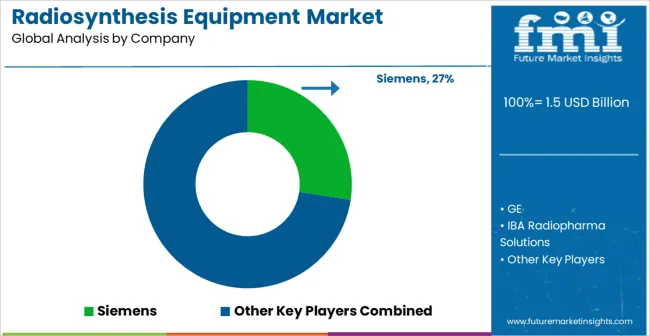The Radiosynthesis Equipment Market is estimated to be valued at USD 1.5 billion in 2025 and is projected to reach USD 3.1 billion by 2035, registering a compound annual growth rate (CAGR) of 7.5% over the forecast period.

| Metric | Value |
|---|---|
| Radiosynthesis Equipment Market Estimated Value in (2025E) | USD 1.5 billion |
| Radiosynthesis Equipment Market Forecast Value in (2035F) | USD 3.1 billion |
| Forecast CAGR (2025 to 2035) | 7.5% |
The Radiosynthesis Equipment market is witnessing steady growth due to the increasing demand for radiopharmaceuticals in diagnostic and therapeutic applications. The adoption of advanced imaging techniques in nuclear medicine and personalized therapy has significantly driven the requirement for reliable and efficient radiosynthesis systems.
Investments in hospital infrastructure, rising prevalence of chronic diseases, and the expansion of PET and SPECT imaging facilities are creating a favorable environment for market growth. The shift towards automation in radiopharmaceutical production is improving accuracy, reducing human error, and enhancing safety, further supporting market expansion.
Additionally, regulatory emphasis on quality and reproducibility in radiopharmaceutical preparation has encouraged the use of advanced equipment With the ongoing focus on molecular imaging and targeted radiotherapy, the market is poised for continued growth, offering opportunities for technology upgrades and the development of innovative automated solutions that streamline production processes and improve operational efficiency in clinical and research settings.
The radiosynthesis equipment market is segmented by product type, end user, and geographic regions. By product type, radiosynthesis equipment market is divided into Fully Automated and Semi-Automated. In terms of end user, radiosynthesis equipment market is classified into Hospitals, Radiology Centers, Diagnostic Laboratories, Research Centers, and Ambulatory Surgical Centers. Regionally, the radiosynthesis equipment industry is classified into North America, Latin America, Western Europe, Eastern Europe, Balkan & Baltic Countries, Russia & Belarus, Central Asia, East Asia, South Asia & Pacific, and the Middle East & Africa.

The Fully Automated product type is projected to account for 55.00% of the Radiosynthesis Equipment market revenue in 2025, positioning it as the leading segment. Its growth has been driven by the increasing emphasis on precision and reproducibility in radiopharmaceutical production, which reduces the risk of contamination and human error.
Fully automated systems provide enhanced efficiency by integrating complex chemical synthesis steps into a single workflow, minimizing manual intervention, and allowing consistent high-quality output. The segment’s prominence is further supported by the rising need for high-throughput production in hospitals and research institutions.
Ease of compliance with stringent regulatory requirements and the ability to handle a variety of radiopharmaceutical compounds without extensive reconfiguration have also contributed to its adoption As demand for advanced molecular imaging and radiotherapy agents grows, fully automated systems are expected to maintain their leadership position by offering scalable, safe, and reliable solutions for both clinical and research applications.

The Hospitals end-use segment is expected to hold 35.00% of the Radiosynthesis Equipment market revenue in 2025, establishing it as the leading user category. This growth is being fueled by the increasing installation of radiopharmaceutical production facilities within hospital environments to support on-site diagnostic imaging and therapeutic procedures.
Hospitals benefit from enhanced workflow efficiency, improved patient throughput, and reduced dependency on external radiopharmaceutical suppliers. The segment’s prominence is reinforced by the growing use of PET and SPECT imaging in oncology, cardiology, and neurology, which drives consistent demand for high-quality radiopharmaceuticals.
Investment in automated radiosynthesis equipment within hospitals ensures compliance with safety and regulatory standards while allowing flexible production schedules for diverse isotopes The ongoing expansion of hospital infrastructure, combined with rising awareness of molecular imaging and personalized medicine, is expected to sustain the growth of this end-use segment, positioning hospitals as a primary driver for market expansion.
Radiosynthesis is a completely automated synthesis which includes production of radioactive compounds. The process is carried by various nuclear interface modules which are further protected by the lead shielding and is semi-automatically controlled by the computer.
Modules are set-up differently depending on the synthesis process and type of product. These Radiosynthesis equipment modules are adapted with the synthesis stages consecutively. Radiosynthesis equipment are also used for molecular labeling and formulation and production of radiotracers.
These radioactive tracers are chemical compounds for which atoms are replaced by the radioisotopes. Radioisotopes are used in diagnostic areas with SPECT and PET. Radiosynthesis equipment are easy-to-use and allows scope for customization of radiotracers.
Results obtained by these Radiosynthesis equipment can further also be used for research purposes and therapeutic nuclear medicine. Government support for diagnostic related researches favors the production of radiosynthesis equipment.
For instance, Department of Energy provided around $1 million phase II grant under the SBIR program for developing micro-scale technology for simple and rapid synthesis of PET probes.

| Country | CAGR |
|---|---|
| China | 10.1% |
| India | 9.4% |
| Germany | 8.6% |
| Brazil | 7.9% |
| USA | 7.1% |
| UK | 6.4% |
| Japan | 5.6% |
The Radiosynthesis Equipment Market is expected to register a CAGR of 7.5% during the forecast period, exhibiting varied country level momentum. China leads with the highest CAGR of 10.1%, followed by India at 9.4%. Developed markets such as Germany, France, and the UK continue to expand steadily, while the USA is likely to grow at consistent rates. Japan posts the lowest CAGR at 5.6%, yet still underscores a broadly positive trajectory for the global Radiosynthesis Equipment Market.
In 2024, Germany held a dominant revenue in the Western Europe market and is expected to grow with a CAGR of 8.6%. The USA Radiosynthesis Equipment Market is estimated to be valued at USD 557.3 million in 2025 and is anticipated to reach a valuation of USD 557.3 million by 2035. Sales are projected to rise at a CAGR of 0.0% over the forecast period between 2025 and 2035. While Japan and South Korea markets are estimated to be valued at USD 80.4 million and USD 51.6 million respectively in 2025.

| Item | Value |
|---|---|
| Quantitative Units | USD 1.5 Billion |
| Product Type | Fully Automated and Semi-Automated |
| End User | Hospitals, Radiology Centers, Diagnostic Laboratories, Research Centers, and Ambulatory Surgical Centers |
| Regions Covered | North America, Europe, Asia-Pacific, Latin America, Middle East & Africa |
| Country Covered | United States, Canada, Germany, France, United Kingdom, China, Japan, India, Brazil, South Africa |
| Key Companies Profiled | Siemens, GE, IBA Radiopharma Solutions, Eckert & Ziegler Group, Synthra, Sumitomo, Sofie Biosciences, Scintomics, Trasis, Posi-Med, ATS Automation Tooling Systems, and PerkinElmer |
The global radiosynthesis equipment market is estimated to be valued at USD 1.5 billion in 2025.
The market size for the radiosynthesis equipment market is projected to reach USD 3.1 billion by 2035.
The radiosynthesis equipment market is expected to grow at a 7.5% CAGR between 2025 and 2035.
The key product types in radiosynthesis equipment market are fully automated and semi-automated.
In terms of end user, hospitals segment to command 35.0% share in the radiosynthesis equipment market in 2025.






Our Research Products

The "Full Research Suite" delivers actionable market intel, deep dives on markets or technologies, so clients act faster, cut risk, and unlock growth.

The Leaderboard benchmarks and ranks top vendors, classifying them as Established Leaders, Leading Challengers, or Disruptors & Challengers.

Locates where complements amplify value and substitutes erode it, forecasting net impact by horizon

We deliver granular, decision-grade intel: market sizing, 5-year forecasts, pricing, adoption, usage, revenue, and operational KPIs—plus competitor tracking, regulation, and value chains—across 60 countries broadly.

Spot the shifts before they hit your P&L. We track inflection points, adoption curves, pricing moves, and ecosystem plays to show where demand is heading, why it is changing, and what to do next across high-growth markets and disruptive tech

Real-time reads of user behavior. We track shifting priorities, perceptions of today’s and next-gen services, and provider experience, then pace how fast tech moves from trial to adoption, blending buyer, consumer, and channel inputs with social signals (#WhySwitch, #UX).

Partner with our analyst team to build a custom report designed around your business priorities. From analysing market trends to assessing competitors or crafting bespoke datasets, we tailor insights to your needs.
Supplier Intelligence
Discovery & Profiling
Capacity & Footprint
Performance & Risk
Compliance & Governance
Commercial Readiness
Who Supplies Whom
Scorecards & Shortlists
Playbooks & Docs
Category Intelligence
Definition & Scope
Demand & Use Cases
Cost Drivers
Market Structure
Supply Chain Map
Trade & Policy
Operating Norms
Deliverables
Buyer Intelligence
Account Basics
Spend & Scope
Procurement Model
Vendor Requirements
Terms & Policies
Entry Strategy
Pain Points & Triggers
Outputs
Pricing Analysis
Benchmarks
Trends
Should-Cost
Indexation
Landed Cost
Commercial Terms
Deliverables
Brand Analysis
Positioning & Value Prop
Share & Presence
Customer Evidence
Go-to-Market
Digital & Reputation
Compliance & Trust
KPIs & Gaps
Outputs
Full Research Suite comprises of:
Market outlook & trends analysis
Interviews & case studies
Strategic recommendations
Vendor profiles & capabilities analysis
5-year forecasts
8 regions and 60+ country-level data splits
Market segment data splits
12 months of continuous data updates
DELIVERED AS:
PDF EXCEL ONLINE
Equipment Management Software Market Size and Share Forecast Outlook 2025 to 2035
Equipment cases market Size and Share Forecast Outlook 2025 to 2035
Farm Equipment Market Forecast and Outlook 2025 to 2035
Golf Equipment Market Size and Share Forecast Outlook 2025 to 2035
Port Equipment Market Size and Share Forecast Outlook 2025 to 2035
Pouch Equipment Market Growth – Demand, Trends & Outlook 2025 to 2035
Garage Equipment Market Forecast and Outlook 2025 to 2035
Mining Equipment Industry Analysis in Latin America Size and Share Forecast Outlook 2025 to 2035
Subsea Equipment Market Size and Share Forecast Outlook 2025 to 2035
Pavers Equipment Market Size and Share Forecast Outlook 2025 to 2035
Tennis Equipment Market Analysis - Size, Share, and Forecast Outlook 2025 to 2035
Galley Equipment Market Analysis and Forecast by Fit, Application, and Region through 2035
Sorting Equipment Market Size and Share Forecast Outlook 2025 to 2035
General Equipment Rental Services Market Size and Share Forecast Outlook 2025 to 2035
Bagging Equipment Market Size and Share Forecast Outlook 2025 to 2035
RF Test Equipment Market Size and Share Forecast Outlook 2025 to 2035
Medical Equipment Covers Market Size and Share Forecast Outlook 2025 to 2035
Telecom Equipment Market Size and Share Forecast Outlook 2025 to 2035
Welding Equipment And Consumables Market Size and Share Forecast Outlook 2025 to 2035
Hunting Equipment and Accessory Market Analysis - Size, Share, and Forecast Outlook 2025 to 2035

Thank you!
You will receive an email from our Business Development Manager. Please be sure to check your SPAM/JUNK folder too.
Chat With
MaRIA